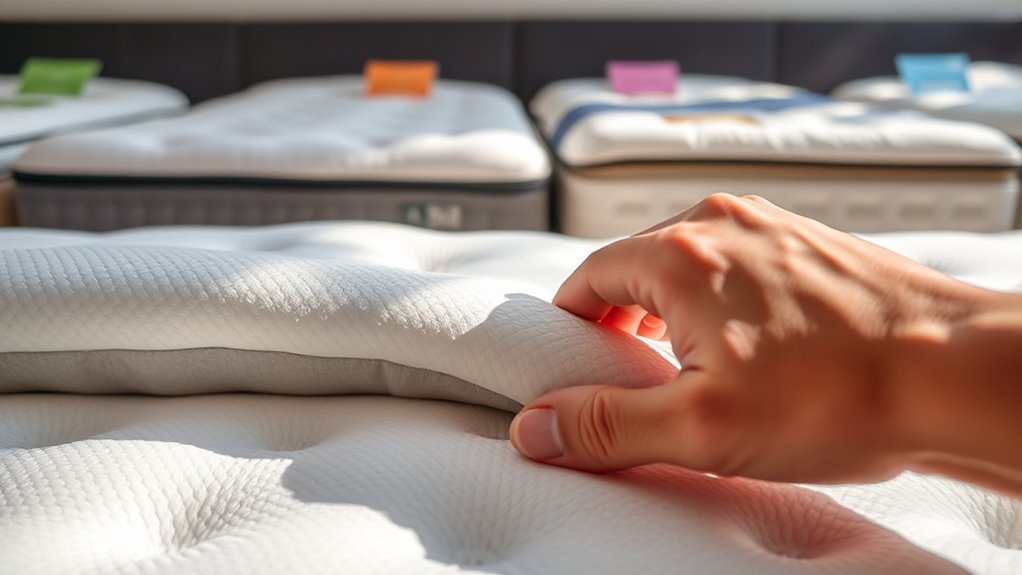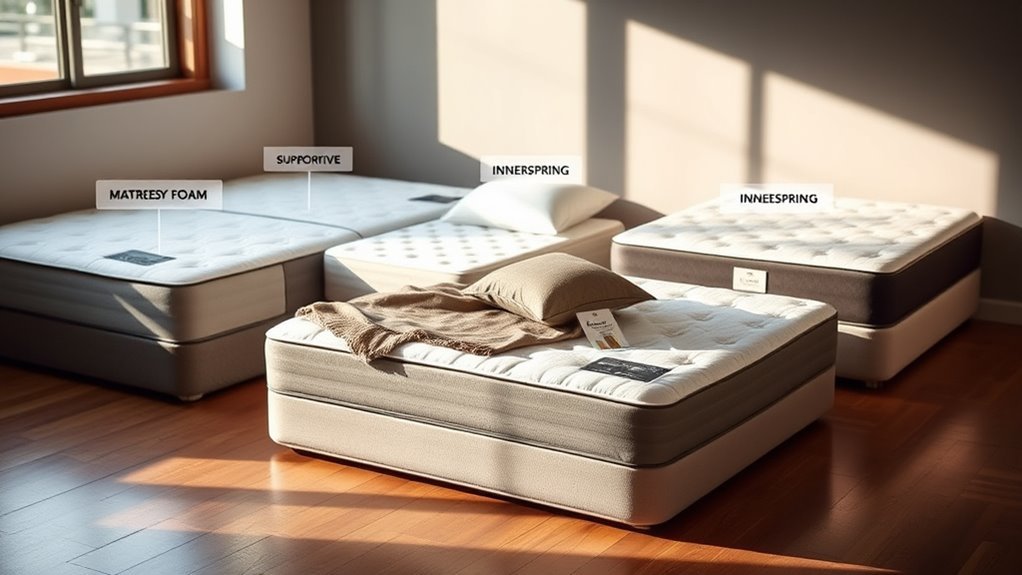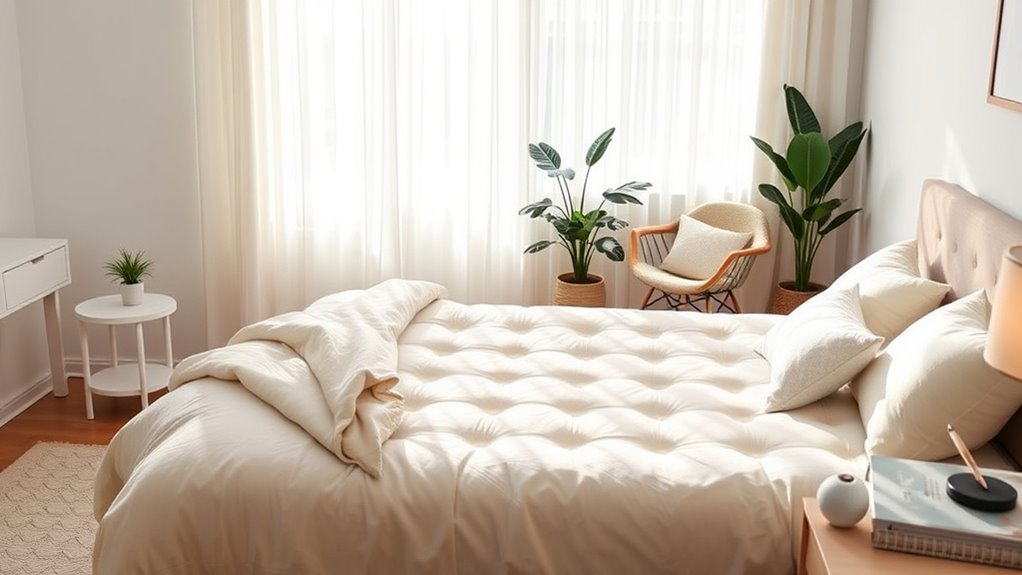To find a budget-friendly mattress for back pain, focus on medium to medium-firm options that support your spine. Look for materials like memory foam or hybrids that contour to your body. Your personal comfort matters, so test different mattresses for firmness. Prices typically range from $200 to $1,000 for decent options. And don’t forget to check return policies to guarantee you’ll be satisfied. There’s more to take into account to truly enhance your sleep quality.
Understanding Back Pain and Sleep Quality

When you struggle with back pain, it can feel impossible to get a good night’s sleep. Poor sleep quality can exacerbate your discomfort, creating a frustrating cycle that saps your energy and happiness. Understanding the relationship between your back pain and sleep is essential for finding pain relief. A supportive mattress can help align your spine, reducing pressure on painful areas and promoting more restorative sleep. Incorporating good sleep hygiene practices, like maintaining a consistent sleep schedule and creating a comfortable sleep environment, can also contribute to improved sleep quality. Remember, prioritizing your rest isn’t just about comfort; it’s a critical step toward reclaiming your freedom from pain and enhancing your daily life. You deserve restful nights and a pain-free morning.
Key Features to Look for in a Mattress

When you’re looking for a mattress to ease back pain, the firmness level is essential since it directly affects your spinal alignment. Additionally, the type of materials used can greatly influence comfort and support, so it’s worth comparing options like memory foam, innerspring, and latex. Understanding these key features will help you make a more informed choice that fits your needs and budget.
Firmness Level Importance
Finding the right firmness level in a mattress is essential, especially if you’re dealing with back pain. The ideal firmness provides the support your spine needs while aligning your body in a natural position. It’s vital to remember that firmness is a personal preference; what feels perfect for one person might not work for another. Generally, medium to medium-firm mattresses tend to be best for back pain, as they offer a balance between support and comfort. You want a mattress that cradles your pressure points without sinking too deeply. Testing different options can help you discover the firmness that makes you feel free and supported, allowing you to wake up refreshed and pain-free. Don’t compromise on your sleep!
Material Types Comparison
As you explore mattress options, understanding the different materials can greatly impact your comfort and support, especially if you suffer from back pain. Memory foam mattresses are known for their ability to contour to your body, providing excellent pressure relief and spinal alignment. They can cradle your curves while minimizing motion transfer, so you won’t feel your partner moving. On the other hand, innerspring mattresses offer a traditional feel with responsive support and breathability. They typically feature coils that promote airflow, keeping you cool. Innerspring comparison shows that they may not provide as much contouring as memory foam, but they can be a solid choice for those who prefer a firmer surface. Ultimately, consider your personal preferences and sleep style.
Types of Mattresses Suitable for Back Pain

Choosing the right mattress can make a significant difference in managing back pain, especially when you’re on a budget. Memory foam mattresses are a popular choice, as they provide excellent support and contour to your body, relieving pressure points. They can help align your spine, which is essential for reducing discomfort. On the other hand, hybrid mattresses combine the benefits of memory foam and innerspring coils, offering both support and comfort. This combination can be particularly effective for those who need a balance of softness and firmness. When selecting a mattress, consider your sleeping position, as it plays a critical role in how well the mattress can support your back. Prioritize your needs to find the perfect fit!
Setting Your Budget: What to Expect
When setting your budget for a mattress, it’s essential to know what to expect regarding price and quality. Mattress pricing can vary widely, influenced by materials, brands, and features. Understanding your personal preferences will also guide your spending. Here’s a breakdown to help you visualize typical pricing:
| Mattress Type | Price Range |
|---|---|
| Budget-Friendly | $200 – $500 |
| Mid-Range | $500 – $1,000 |
| Premium | $1,000 – $2,000 |
| Luxury | $2,000 and up |
Each category offers different benefits, so consider what aligns with your needs. Investing wisely can lead to better sleep and relief from back pain, giving you the freedom to enjoy your days pain-free.
Where to Shop for Affordable Mattresses
Wondering where to find an affordable mattress that won’t compromise on quality? You’ve got options! Start by exploring online retailers, which often offer competitive prices and a wide selection. Sites like Amazon and specialty mattress companies frequently run sales and provide customer reviews to guide your decision. If you prefer a hands-on approach, check out local showrooms. They allow you to test different mattresses and get a feel for what suits your back best. Plus, many showrooms have clearance sections for budget-friendly finds. Don’t forget to ask about financing options or discounts for first-time buyers. With a bit of research, you’ll discover a mattress that meets your needs without breaking the bank. Happy shopping!
Tips for Testing Mattresses Before Buying
When you’re testing mattresses, it’s vital to find the right firmness level that supports your back. Don’t forget to assess how well the mattress relieves pressure points; this can make a big difference in your comfort. Taking the time to test these features can help guarantee you choose a mattress that truly meets your needs.
Test for Firmness Level
Before you invest in a mattress, it’s important to determine the right firmness level for your back pain relief. Start your mattress testing by using the firmness scale, which typically ranges from soft to extra firm. Lie down on each mattress for at least 10-15 minutes in your usual sleeping position. Pay attention to how your body feels; you shouldn’t experience any discomfort in your lower back. If the mattress feels too soft, it may not provide adequate support, while a mattress that’s too firm can lead to pressure points. Remember, the goal is to find a balance that allows your spine to align properly while offering the comfort you need for a restful night.
Assess Pressure Relief Features
As you search for a mattress that alleviates back pain, evaluating pressure relief features is essential for ensuring a comfortable sleep experience. Consider using pressure mapping technology to identify how well a mattress distributes your weight. This can help you see where your body feels the most pressure based on different sleep positions. When testing a mattress, lie on your back, side, and stomach to determine how it reacts to your unique shape. Look for materials like memory foam or latex that contour to your body while providing support. Remember, the right pressure relief can reduce discomfort and promote better alignment, allowing you to enjoy a rejuvenating night’s sleep without breaking the bank.
The Importance of a Good Return Policy
A generous return policy can be a lifesaver when you’re investing in a mattress to alleviate back pain. You deserve the freedom to test your mattress without pressure, ensuring it truly meets your needs. A flexible return policy not only reflects a commitment to customer satisfaction but also gives you peace of mind. You might find that a mattress feels perfect in the store but doesn’t work for you at home. Knowing you can return it if it doesn’t provide the relief you seek allows you to explore options confidently. Look for brands that offer extended trial periods, as this shows they believe in their product. Remember, your comfort and health should always come first in this important decision.
Frequently Asked Questions
How Often Should I Replace My Mattress for Back Pain Relief?
You should replace your mattress every 7 to 10 years for ideal sleep quality and back pain relief. Studies show that nearly 80% of people experience improved sleep after getting a new mattress. A mattress’s lifespan diminishes over time, affecting how well it supports your body. If you’re waking up with pain or feeling unrested, it might be time to invest in a new mattress that can give you the freedom to sleep comfortably again.
Can I Use a Mattress Topper Instead of Buying a New Mattress?
Yes, you can use a mattress topper instead of buying a new mattress. A good topper can enhance comfort and support, especially if it’s made from materials like memory foam or latex. The benefits include improved pressure relief and better spinal alignment, which can help alleviate back pain. Just make sure to choose a topper that suits your sleeping style and preferences, giving you the freedom to enjoy restful nights without breaking the bank.
What Is the Ideal Firmness Level for Back Pain?
Ah, the quest for the perfect firmness—a journey worthy of a knight! For back pain, you’ll want a medium-firm mattress; it balances support and comfort like a tightrope walker. Memory foam or latex materials conform to your shape, cradling you while you sleep. If you’re a side sleeper, a softer option could ease pressure points, while back sleepers might prefer something firmer. Just remember, it’s all about finding your personal sweet spot!
Are There Specific Brands Known for Budget-Friendly Back Pain Mattresses?
Yes, there are several budget brands known for offering mattresses that can help with back pain. Look for options from brands like Zinus, Tuft & Needle, and Lucid. These brands often use memory foam or hybrid materials that provide good support and comfort. When shopping, pay attention to customer reviews to confirm you’re getting a quality product. You deserve a mattress that supports your back without breaking the bank!
How Can I Maintain My Mattress for Longevity and Comfort?
Did you know that a well-maintained mattress can last up to 10 years? To guarantee yours provides proper support and comfort, clean it regularly by vacuuming and spot cleaning stains. Rotate it every three months to prevent sagging and uneven wear. Protect it with a mattress cover to guard against dust mites and allergens. By taking these steps, you’ll extend your mattress’s life and enjoy restful nights, free from discomfort.



